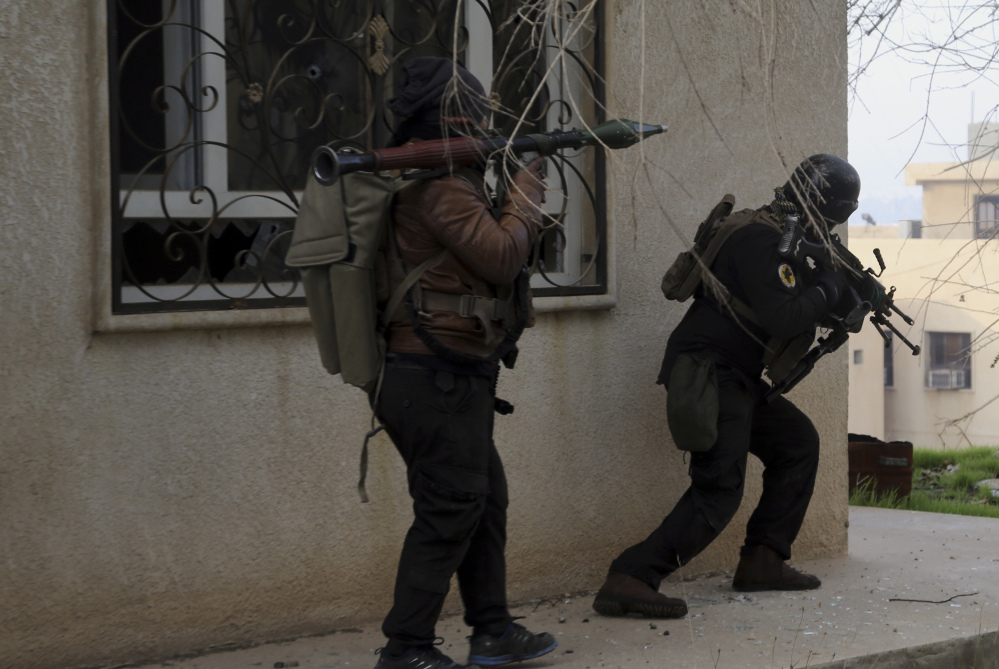MOSUL, Iraq — It was the dead of night when Iraqi commandos advanced into the neighborhood deep in eastern Mosul.
Dozens of the black-clad soldiers waded across a small river that separated them from Islamic State positions. Night vision goggles cast the terrain in front of them in a greenglow.
On the other side, they fought house to house, helping the engineering teams make space for the main attack force. The Humvees then rolled through.
The surprise nighttime attack in the Muthanna neighborhood last week is among the adjustments Iraqi forces are making to jump-start their fight to take the northern city of Mosul. It was the first night operation in their fight against the Islamic State.
In recent weeks, the number of advisers from the U.S.-led coalition assisting them has also increased and airstrikes used to disrupt deadly car bombs have intensified.
Although Islamic State snipers took potshots at passing Humvees a day after Muthanna was retaken, the battle here was largely over in a matter of hours. Iraqi forces have also advanced in other neighborhoods, seizing the university, government buildings and reaching the Tigris River, which carves the city in two.
HOPE REVIVED
“They fled,” a 50-year-old teacher, who was staying at a relative’s house that is now on the front line in Muthanna, said of the militants. “It’s like we were buried and now we can breathe again.”
It’s a shift in tempo in what had become an exhausting street-to-street battle in the militants’ last major stronghold in the country. Iraqi forces say they now control more than 80 percent of the eastern side of Mosul, and bridges to the west have been bombed, making it difficult for the militants to move in reinforcements.
But after three years of relentless fighting, the beleaguered Iraqi troops will soon have a new battle to wage. On the other side of the Tigris is western Mosul, home to the city’s main government buildings and even more densely packed with civilians.
In the first months after the offensive began last fall, Iraqi troops suffered heavy losses, largely from car bombs, the Islamic State’s most ferocious weapon. The casualty rate for elite Iraqi counterterrorism units doing the bulk of the fighting had reached about 20 to 25 percent, according to a general, who spoke on the condition of anonymity.
The rate has dropped since the Iraqi government restarted the offensive two weeks ago after a pause during which forces were reorganized, said Brig. Gen. Yahya Rasoul, spokesman for Iraq’s Joint Operations Command. “We are using new tactics and strategies, and we have reduced the casualties during the second phase.”
He said the losses among Iraqi forces are insignificant compared with Islamic State deaths in the battle. Iraqi commanders say at least 2,500 militants have been killed.
Since the operation has restarted, the U.S.-led coalition has “significantly intensified” what are known as “terrain denial strikes,” said Col. John Dorrian, a coalition spokesman. Such strikes leave craters in roads that slow down or stop would-be car bombers.
Iraqi forces have also made greater inroads into the city, opening multiple fronts against the militants and relieving pressure on the elite counterterrorism troops. Some military analysts say that pressing so far into the city before it was completely isolated was a miscalculation.
REINFORCEMENTS ARRIVE
“The counterterrorism units shouldn’t have started in the east until the other axes had arrived,” said David M. Witty, a retired U.S. Army Special Forces colonel and a former adviser to the Iraqi counterterrorism force. “It was a mistake. (The Islamic State) was able to focus all its fighters on them.”
The counterterrorism forces have been reinforced with about 300 new soldiers, according to Lt. Gen. Abdul Ghani al-Asadi. They have also received about 70 new Humvees, and a graveyard of wrecked ones on the road into Mosul has been cleared. About 40 new advisers from the U.S.-led coalition are assisting in and around Mosul, Dorrian said.
But the militants are also making adjustments. Car bombs have become less frequent, although those that are used are now largely in civilian vehicles rather than fearsome steel-plated trucks, making them less effective but harder to spot. The militants are also using armed drones more often, soldiers say.
The crack of machine-gun fire filled the air as several Islamic State drones buzzed over a convoy carrying Iraqi generals to survey the front lines in Muthanna. Two were shot down.
Copy the Story LinkSend questions/comments to the editors.



Success. Please wait for the page to reload. If the page does not reload within 5 seconds, please refresh the page.
Enter your email and password to access comments.
Hi, to comment on stories you must . This profile is in addition to your subscription and website login.
Already have a commenting profile? .
Invalid username/password.
Please check your email to confirm and complete your registration.
Only subscribers are eligible to post comments. Please subscribe or login first for digital access. Here’s why.
Use the form below to reset your password. When you've submitted your account email, we will send an email with a reset code.